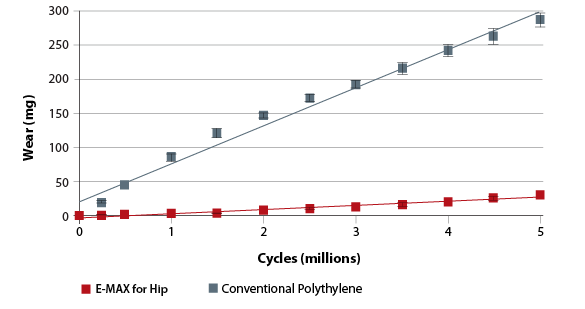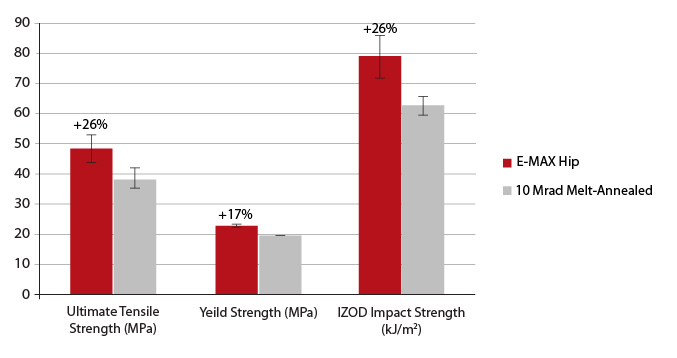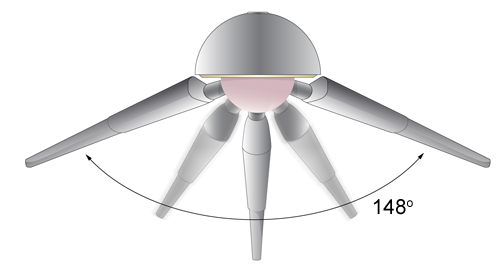![]()
E-MAX underwent extensive laboratory evaluations, including mechanical, material characterization, and wear simulator testing. Performance was compared to both conventional (3.5 Mrad sterilized) and 10 Mrad highly crosslinked polyethylene (XLPE).
Excellent Wear Properties
The crosslinking density of E-MAX for hip was fine-tuned to be about the same as 10 Mrad XLPE and has demonstrated similarly low wear in hip simulator testing: 89% less wear than conventional polyethylene.[Figure 1] [1]
Figure 1: Hip Simulator Wear. 40 mm heads and liners. [1]

Improved Mechanical Properties
Compared 10 Mrad melt-annealed XLPE, E-MAX for hip demonstrated significant tensile strength and impact toughness improvements. [Figure 2] [2,3]
Figure 2: Tensile and IZOD impact test results for E-MAX Highly Crosslinked Polyethylene (Hip). Percentages indicate relative improvement over 10 Mrad melt-annealed XLPE. [2,3]

Fatigue crack propagation analysis comparing E-MAX to melt-annealed XLPE demonstrated:
- E-MAX had a significantly higher stress intensity factor for crack initiation, meaning it is more resistant to crack initiation than melt-annealed XLPE. [5]
- E-MAX had an overall decreased crack propagation rate compared to melt-annealed XLPE. [5]
Oxidative Stability under Harsh Testing Conditions
The mechanical anneal process eliminates free radicals to near the detection threshold of the testing equipment (electron spin resonance testing). [4,5] After accelerated aging, E-MAX showed minimal change in free radical content, indicating that the Vitamin E stabilized the free radicals, preventing them from reacting with oxygen. [5] To further test oxidation resistance under extreme conditions, samples were exhaustively extracted to remove as much Vitamin E as possible, and then subjected to accelerated aging. Even under extreme conditions, no positive oxidation index was measured in E-MAX. [5]
Evenly Distributed Vitamin E
Chemical analysis demonstrated that the Vitamin E profile is constant throughout E-MAX, indicating that it is evenly distributed throughout the material. [5] This is because vitamin E is blended with UHMWPE powder before creating the UHMWPE barstock. In contrast, materials into which the vitamin E is diffused after UHMWPE consolidation (e.g. Biomet E1), result in more concentrated levels of vitamin E near the surface.
Stability with large diameter heads
Larger diameter heads have been shown to lead to improved range of motion and lower dislocation rates. [6-9] E-MAX acetabular inserts are available for use with heads up to 40 mm in diameter.

- University of Nebraska Medical Center. Characterization of CIMA and E-CIMA UHMWPE as a bearing against CoCr femoral hip components: A hip simulation study. Test report dated July 15, 2011. On file with KYOCERA Medical Technologies, Inc.
- Materials Characterization testing. Test report TP0322. On file with KYOCERA Medical Technologies, Inc.
- Bhattacharyya S, Matrisciano L, Spiegelberg S, Harris W, Muratoglu O. Mechanical elimination of residual free radicals in an irradiated UHMWPE rod: advantages over melting. 50th annual meeting of the orthopaedic research society. 2004:1474.
- Wannomae KK, Micheli BR, Lozynsky AJ, Muratoglu OK. A New Method of Stabilizing Irradiated UHMWPE Using Vitamin E and Mechanical Annealing. 11th Congress EFFORT. Madrid, Spain. June 2010.
- Cambridge Polymer Group. Analysis of CIMA and E-CIMA Material. Test report dated July 15, 2011. On file with KYOCERA Medical Technologies, Inc.
- Peters CL, McPherson E, Jackson JD, Erickson JA. Reduction in early dislocation rate with large-diameter femoral heads in primary total hip arthroplasty. J Arthroplasty 2007;22(6 Suppl 2):140-4.
- Beaule, Schmalzried, Udomkiat, Amstutz. Jumbo Femoral Head for the Treatment of Recurrent Dislocation Following Total Hip Replacement. JBJS(Am) 2002; 84(2): 256-63, 2002.
- Callaghan JJ, Heithoff BE, Goetz DD, Sullivan PM, Pedersen DR, Johnston RC Prevention of dislocation after hip arthroplasty: lessons from long-term followup. Clin Orthop Relat Res 2001; 393:157-62.
- Van Sikes C, Lai LP, Schreider M, Mont MA, Jinnah RH, Seyler TM. Instability after total hip arthroplasty: treatment with large heads vs constrained liners. J Arthroplasty 2008; 23(7): 59-63.